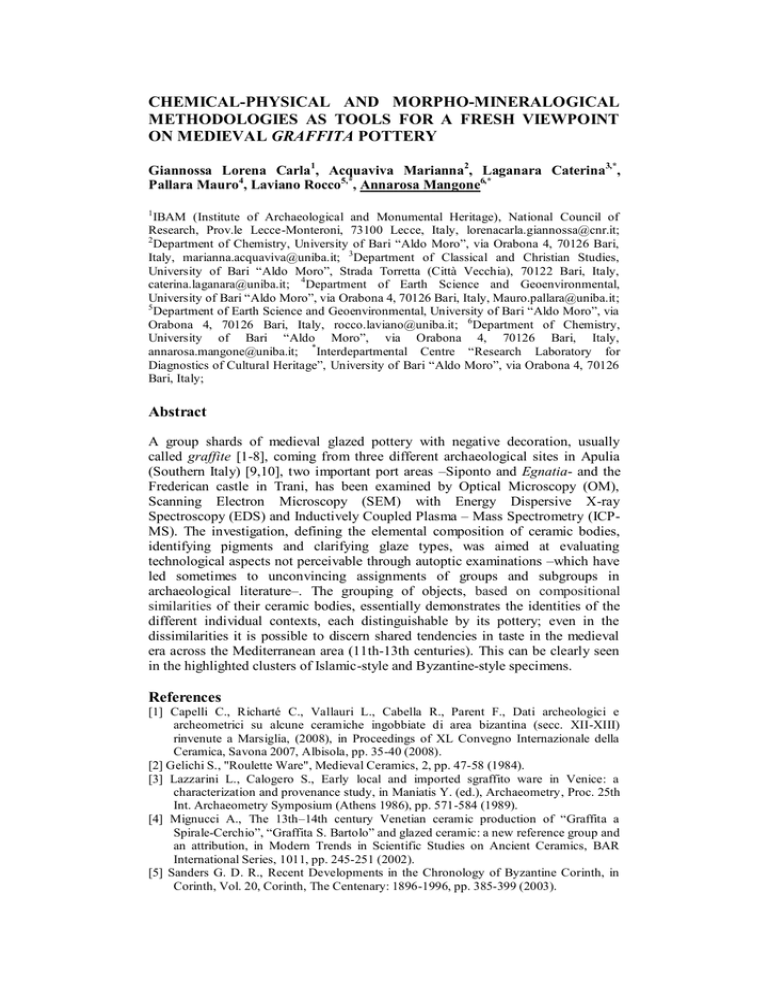chemical-physical and morpho-mineralogical
advertisement

CHEMICAL-PHYSICAL AND MORPHO-MINERALOGICAL METHODOLOGIES AS TOOLS FOR A FRESH VIEWPOINT ON MEDIEVAL GRAFFITA POTTERY Giannossa Lorena Carla1, Acquaviva Marianna2, Laganara Caterina3,*, Pallara Mauro4, Laviano Rocco5,*, Annarosa Mangone6,* 1 IBAM (Institute of Archaeological and Monumental Heritage), National Council of Research, Prov.le Lecce-Monteroni, 73100 Lecce, Italy, lorenacarla.giannossa@cnr.it; 2 Department of Chemistry, University of Bari “Aldo Moro”, via Orabona 4, 70126 Bari, Italy, marianna.acquaviva@uniba.it; 3Department of Classical and Christian Studies, University of Bari “Aldo Moro”, Strada Torretta (Città Vecchia), 70122 Bari, Italy, caterina.laganara@uniba.it; 4Department of Earth Science and Geoenvironmental, University of Bari “Aldo Moro”, via Orabona 4, 70126 Bari, Italy, Mauro.pallara@uniba.it; 5 Department of Earth Science and Geoenvironmental, University of Bari “Aldo Moro”, via Orabona 4, 70126 Bari, Italy, rocco.laviano@uniba.it; 6Department of Chemistry, University of Bari “Aldo Moro”, via Orabona 4, 70126 Bari, Italy, annarosa.mangone@uniba.it; *Interdepartmental Centre “Research Laboratory for Diagnostics of Cultural Heritage”, University of Bari “Aldo Moro”, via Orabona 4, 70126 Bari, Italy; Abstract A group shards of medieval glazed pottery with negative decoration, usually called graffite [1-8], coming from three different archaeological sites in Apulia (Southern Italy) [9,10], two important port areas –Siponto and Egnatia- and the Frederican castle in Trani, has been examined by Optical Microscopy (OM), Scanning Electron Microscopy (SEM) with Energy Dispersive X-ray Spectroscopy (EDS) and Inductively Coupled Plasma – Mass Spectrometry (ICPMS). The investigation, defining the elemental composition of ceramic bodies, identifying pigments and clarifying glaze types, was aimed at evaluating technological aspects not perceivable through autoptic examinations –which have led sometimes to unconvincing assignments of groups and subgroups in archaeological literature–. The grouping of objects, based on compositional similarities of their ceramic bodies, essentially demonstrates the identities of the different individual contexts, each distinguishable by its pottery; even in the dissimilarities it is possible to discern shared tendencies in taste in the medieval era across the Mediterranean area (11th-13th centuries). This can be clearly seen in the highlighted clusters of Islamic-style and Byzantine-style specimens. References [1] Capelli C., Richarté C., Vallauri L., Cabella R., Parent F., Dati archeologici e archeometrici su alcune ceramiche ingobbiate di area bizantina (secc. XII-XIII) rinvenute a Marsiglia, (2008), in Proceedings of XL Convegno Internazionale della Ceramica, Savona 2007, Albisola, pp. 35-40 (2008). [2] Gelichi S., "Roulette Ware", Medieval Ceramics, 2, pp. 47-58 (1984). [3] Lazzarini L., Calogero S., Early local and imported sgraffito ware in Venice: a characterization and provenance study, in Maniatis Y. (ed.), Archaeometry, Proc. 25th Int. Archaeometry Symposium (Athens 1986), pp. 571-584 (1989). [4] Mignucci A., The 13th–14th century Venetian ceramic production of “Graffita a Spirale-Cerchio”, “Graffita S. Bartolo” and glazed ceramic: a new reference group and an attribution, in Modern Trends in Scientific Studies on Ancient Ceramics, BAR International Series, 1011, pp. 245-251 (2002). [5] Sanders G. D. R., Recent Developments in the Chronology of Byzantine Corinth, in Corinth, Vol. 20, Corinth, The Centenary: 1896-1996, pp. 385-399 (2003). [6] Waksman S.Y., François V., Vers une redéfinition typologique et analytique des céramiques byzantines du type Zeuxippus Ware, Bulletin de Correspondance Hellénique, 128-129.2.1, pp. 629-724 (2004-2005). [7] Waksman S.Y., von Wartburg M.L., "Fine-Sgraffito Ware", "Aegean Ware", and other wares: new evidence for a major production of Byzantine ceramics, Report of the Department of Antiquities, Cyprus, pp. 369-388 (2006). [8] White H.E., acksonC.M. J, Sanders G.D.R., Byzantine glazed ceramics from Corinth: testing provenance assumptions, Proceedings ISA 2006, 36th International Symposium on Archaeometry, Cahiers d’archéologie du CELAT 25 (2009). [9] Bruno, P.; Caselli, M.; Curri, L.; Favia, P.; Laganara, C.; Mangone, A.; Traini, A. In: Medieval pottery in Southern Italy: an archaeometrical approach, Proceedings of 1st Int. Congr. on Science and technology for the safeguard of cultural heritage in the Mediterranean basin, Catania, November 27- December 2; pp. 771-776 (1995). [10] Bruno, P.; Caselli, M.; Curri, L.M.; Laviano, R.; Mangone, A.; Manigrassi, D.; Traini, A. Indagine archeometrica sui materiali: caratterizzazione chimico-fisica dei rivestimenti, dei pigmenti e dei corpi ceramici. In: La ceramica medievale di Castel Fiorentino. Dallo scavo al museo, Laganara, C.; Ed; Ed. Adda: Bari, pp. 107-131 (2004).